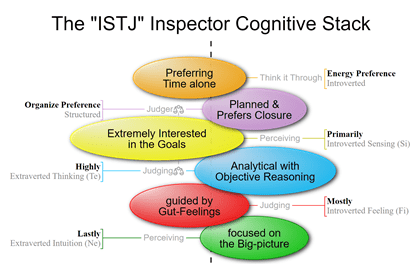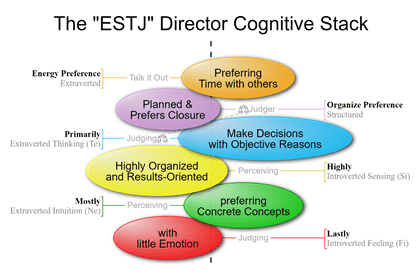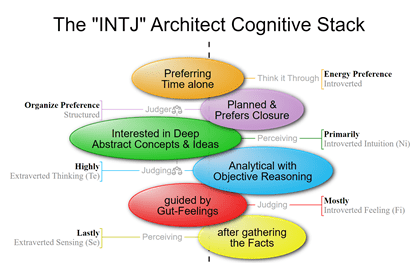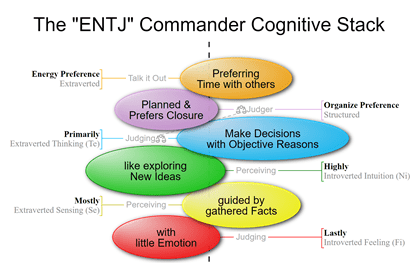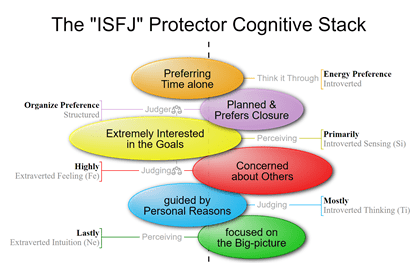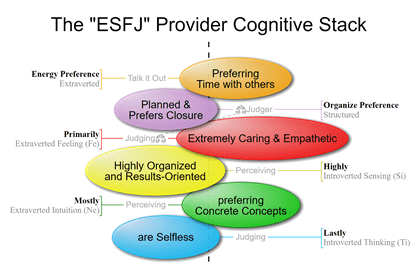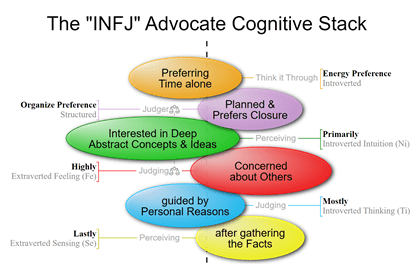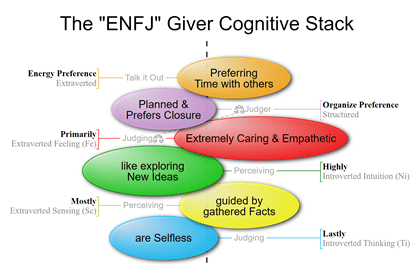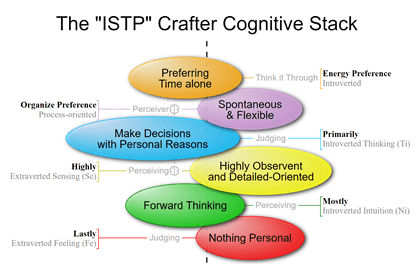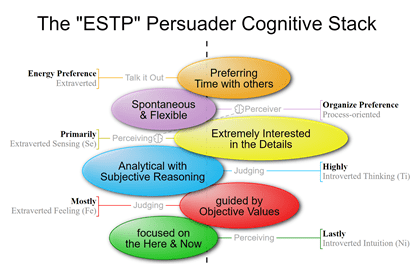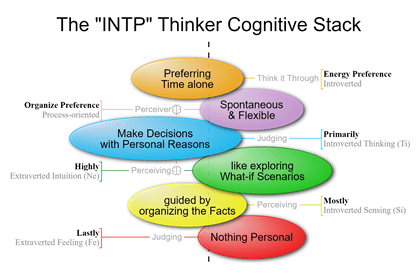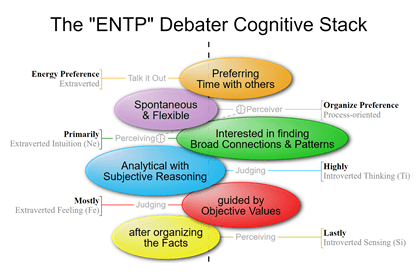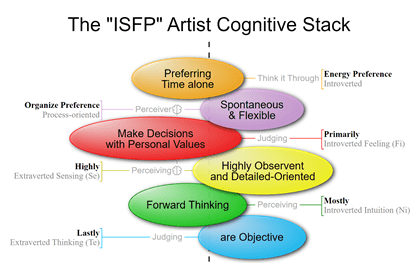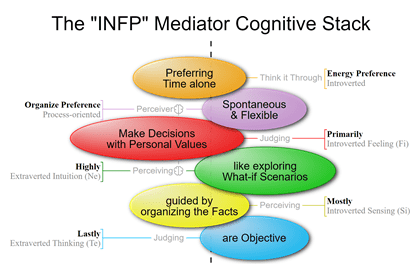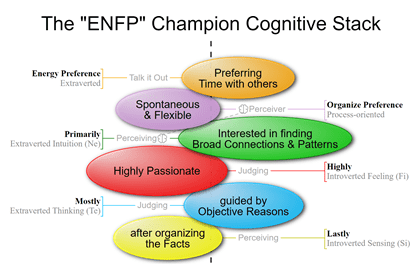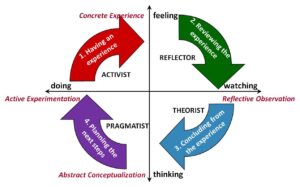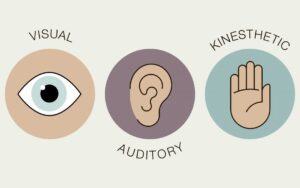
Virginia Satir, a world-famous therapist specializing in family therapy, proposed that when we become insecure or threatened, we communicate defensively and cannot remain honest, direct, and open with the person we are talking with. Viginia identified and categorized five communication styles, or behaviors, which she called modes: Blamer, Placater, Computer, Distracter, and Leveler.

We all have a Satir Mode that we feel most comfortable and favor using. To determine your preferred Satir Mode, carefully listen to yourself as you communicate with others. Pay close attention to your posture, facial expressions, tone of voice, and language.
Virginia initially used the communication categories to help individual family members become aware of their incongruent behavior. Incongruent behavior occurs when one’s mind thinks one thing, but one’s body does another, such as faking a smile. People intuitively sense something is incongruent, and this creates conflict.
MBTI Judging Function and the Satir Communication Styles
A defensive communication style results from an unhealthy use of one of the MBTI Judging Attitudes. Thinking and Feeling are Judging functions, while Sensing and Intuition are Perceiving functions.
The topmost Extraverted Function, which may be the first Dominant Function or the second Auxiliary Function; whichever is the top Extraverted Function, determines if you are a Judger or a Perceiver type of person.
If our highest Extraverted Function is decision-making, we prefer Judging. If our highest Extraverted Function is information-gathering, we like Perceiving.
Thinking refers to how people make decisions based on reasons. Introverted Thinking people base their decisions on personal grounds. On the other hand, extroverted thinking people base their decisions on considering objective reasons.
The Feeling function guides how people make decisions based on values. Introverted Feeling people have more subjective values. You found your decisions on principles and personal matters. At the same time, Extraverted Feeling people are more objective and base their decisions on considering other people’s feelings and socially acceptable values.
The “Blaming” Communication Style
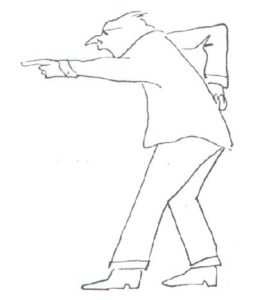
Blamer behavior finds fault — never accepting responsibility themselves, always blaming someone or something else.
The Blamer hides feelings of alienation and loneliness behind an authoritarian and complacent mask.
Blaming occurs when someone becomes overly critical of another person and is more likely to initiate conflict.
The Blamer’s posture will be aggressive, with apparent hostility and a harsh tone to clear themselves of all accountability, no matter how trivial.
Blamers are determined in their language to ensure that responsibility for anything that goes wrong or might go wrong is placed on somebody else’s shoulders. And they prefer to make that responsibility permanent.
You can recognize a Blamer’s body language relatively easily. Watch for clenched fists, gritted teeth, choppy gestures, and a posture that makes the person seem to loom over you.
The Blamer takes responsibility for self and puts it on someone or something else. They only recognize their view and don’t respect the other person’s view.
The Blamer’s language is authoritarian and direct. They tend to disagree, highlight important points, and find fault with everything you do or say.
Blamers use generalizations to distract and blame someone and use pointing gestures.
The Blamer’s stance appears harsh and is used to make firm points and elicit guilt. It can quickly create relationship rifts and communication problems. The Blamer posture can trigger the Placatory posture—a fear response to intimidation in others.
Blamers play hardball in negotiations. They want to win at any cost and can sometimes cut off their nose to spite their face or win the battle only to lose the war.
Virginia suggested that 30% of people typically use the Satir Categories Blamer attitude.
Body Posture
- They point with a finger.
- Have a tense, distorted, flat, compressed breath.
Facial Expression
- Tense facial muscles.
- Pursed lips.
- Shows expanded nasal passages.
- An annoyed look.
Voice
- Scream with a stern voice, tense, shrill.
Linguistic Structures
- Universal quantifiers: all, everyone, never, everything, always, every time
- Assumed causal relationships (if, then: because)
- Use of negative questions: Why not do it?
MBTI Thinking and Judging Types as Blamers
MBTI Thinking and Judging Types can sometimes become Blamers when feeling defensive.
The MBTI ISTJ and ESTJ Personality Types are “Concrete Judgers” with Introverted Sensing and Extraverted Thinking. When threatened, they will disapprove of you in terms of details.
The MBTI INTJ and ENTJ Personality Types are “Abstract Judgers” with Introverted Intuition and Extraverted Thinking. When threatened, use a more abstract way of proving that you have done something wrong.
The “Placating” Communication Style

Placaters are out to please, non-assertive, never disagreeing, and always seeking approval. They avoid conflict. Their main concern is how other people perceive them.
In a certain respect, the Placing communication behavior is the opposite of Blaming, which occurs when one is overly self-critical and uses an apologetic posture and tone of voice.
The Placater is also concerned about placing blame but takes a different approach from the Blamers. Like the Blamer, the Placater wants responsibility placed elsewhere. But unlike the Blamer, the Placater doesn’t care where responsibility is placed, just so long as they don’t have to take it on.
The Placater also differs from the Blamer in using language to deny responsibility for bad and good things. Where the Blamer is an obvious verbal bully, the Placater is an equally apparent verbal victim, a wiggling cocker spaniel puppy of language.
The Placater takes all responsibility onto self and takes it off other people. They respect other people’s views and the context of a situation, not their point of view. This stance draws sympathy but can appear weak-spirited.
The Placater typically has open body language with palms up or out towards the audience or other person and hunched shoulders, and their language is agreeable and pleasing.
Being in this attitude can sometimes trigger others’ Blamer attitude – a desire to dominate or take control. Others can get annoyed they are being such wimps.
Placaters can sacrifice themselves for others – and are willing to lose so others can win. “Whatever you want is OK, don’t worry about me.”
Virginia suggested that 50% of people typically adopt the satirical placater attitude. They say yes regardless of what they feel or want.
Body Posture
- Body in a low position, as if kneeling, begging, and saying yes to everything.
- They are slumped over, swaying, with their head turned upwards, and hands held forward pleadingly.
Facial Expression
- Sad facial gesture.
- They look at the floor.
Voice
- Nasal voice, with a complacent tone, whining, squeaky, and pressed.
Linguistic Structures
- Use of restrictions: if, only, even, at all.
- Use many subjunctives: could, would, might, should, etc.
MBTI Feeling and Judging Types as Placaters
When feeling defensive, the MBTI Feeling and Judging Types will likely become Placaters based on their preference to use Feeling to deal with the world. This tendency to be empathetic with and accommodating to others can quickly turn into Placating if taken too far.
The MBTI Personality Types ISFJ and ESFJ are “Concrete Judgers” with Introverted Sensing and Extraverted Feeling. Feeling threatened is likelier to be overly apologetic over specific actions and out of touch with his overall goodness.
The MBTI Personality Types INFJ and ENFJ are “Abstract Judgers” with Introverted Intuition and Extraverted Feeling. Feeling threatened, they are more likely to be so invested in his general negative view of themselves that they overlook details that contradict that view.
“Computing or Super-Reasonable” Communication Style

Computer behavior is correct and proper but displays no emotion, masking a feeling of vulnerability.
A Computer-type communicator can be a firework of emotions inside while appearing calm and super-rational on the outside.
They often say value judgments without indicating who could have made the judgment, which implies that everyone would agree.
With a rigid posture, Computing or Super-Reasonable communication behavior hides feelings behind dry, unemotional, and impersonal language.
Blamer’s communication language places all responsibility on others, while Placater’s language denies all responsibility but carefully does not assign it to anyone or anything else.
In contrast, Computer communication language places all responsibility firmly on abstractions. It tries to deflect responsibility from a person to the context of a situation.
Computer communicators will use analytical, disconnected language to be calm and relaxed. They focus on choosing the right words and avoiding mistakes. The disconnection becomes a barrier to Feeling.
A favorite Computer behavior gesture is a hand on the chin (think Rodin’s “The Thinker”) or arms crossed, physically isolating themselves from an issue.
The Computer communication posture can trigger a Distracter stance in the others, even if they don’t typically use it.
Virginia suggested that 15% of people typically use the Computer attitude.
Body Posture
- A straight body posture and a feeling of tranquility and control.
- Unanimated, stiff, non-reactive.
Facial Expression
- Does not finch
- Does not show emotions
- Direct gaze
Voice
- Monotonous and dry.
Linguistic Structures
- Omission of nominative arguments.
- Use the longest possible words, even if unsure of the meanings.
- Deletion of reference indices.
- Use of nominalizations.
- Use nouns without reference indices: it, one, people, etc.
- Deletion of the subject/subject reference.
MBTI Thinking and Perceiving Types as Computers
The MBTI Thinking and Perceiving Types will resort to being Computers when feeling threatened. When defensive, they typically appear unfeeling and aloof, primarily or even wholly devoid of empathy.
The MBTI Personality Types ISTP and ESTP are “Concrete Perceivers” with Introverted Thinking and Extraverted Sensing. When they feel threatened, they speak in a dry, emotionally detached way; when they are more practical, they refer to specific details and issues.
The MBTI Personality Types INTP and ENTP are “Abstract Perceivers” with Introverted Thinking and Extraverted Intuition. Feeling threatened, they talk in dry, emotionally disconnected theoretical language.
The “Distracting” Communication Style
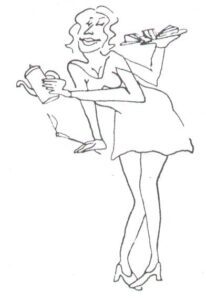
Distractors seek attention to compensate for their feelings of loneliness or inadequacy.
Rather than positive action, Distractors use a range of emotions, from anger to guilt, to either avoid an issue or manipulate how others feel.
Distracting communication behavior is abrupt and illogical, lurching from one unfinished statement, mood, and action to another.
The Distracter will use all three Satir Modes described above but never settles on one long enough for anybody to notice. They will cycle through the Blamer, Placater, and Computer Modes in a way that gives an impression of total disorganization, nonsensical, and even silly.
The only thing you are unlikely to encounter in a Distractor is silence—they can’t go without saying or doing something, no matter how inappropriate.
A Distracter’s gestures will typically be unbalanced, like one arm up, one arm down, and their head cocked. Their stance can trigger another person’s Computer (or Super Reasonable) posture.
A person skilled at communication can move quickly from one Satir Mode to another, choosing the one best for the particular situation and time. However, this is distinctly different from what the Distracter does, which uses the different Satir Modes almost randomly without making reasoned choices.
Body Posture
- The body goes in different directions (uncoordinated movements).
- They are exaggeratedly joining the knees and bending the shoulders.
Facial Expression
- Distracted.
- Lazy.
- Entertaining.
- Distracted gaze.
Voice
- Singsong that clashes with words, erratic, fast, and animated.
Linguistic Structures
- Arbitrary use of all three language patterns, missing references and links, and rapid other patterns change.
- Words without meaning and irrelevant.
MBTI Sensing and Perceiving Types as Distractors
The MBTI ISFP and ESFP Personality Types are “Concrete Perceivers” with Introverted Feelings and Extraverted Sensing. When feeling threatened, they will be distracted in a kinesthetic manner, with observable erratic physical gestures and posture changes, and with less reliance on ideas.
The MBTI INFP and ENFP Personality Types are “Abstract Perceivers” with Introverted Feelings and Extraverted Intuition. When feeling threatened, they will use logically unconnected messages through nonsequiturs in their speech.
The “Leveling” Communication Style
Levelers have emotional balance, can relate to all kinds of people, and are assertive. The goal of leveling is mutual problem-solving.
Levelers have few threats to their self-esteem. Words, voice tone, body movements, and facial expressions all give the same message.
People can use the Leveler communication behavior to resolve conflict and bring people together. The distinction of the Leveler is that they have real-time, congruent responses. All the other reactions result from negative internal feelings, causing words and actions to be incongruent.
Levelers are congruent in their beliefs, respecting their views, other people’s views, and the context of a situation. They show no symptoms of the different stress stances.
The Leveler appears knowledgeable and speaks in fact. Their gestures are symmetrical, particularly around the waist, which shows credibility while giving a speech.
Levelers look for win/win. They take a solution-based problem-solving stance. In negotiation, this attitude focuses on the facts and the basis for the talks.
- Levelers apologize when they are in the wrong (rather than appease).
- Levelers can evaluate a situation (rather than blaming a person).
- Levelers know when abstract language is appropriate, like when talking to other experts or when they genuinely need to be objective (rather than avoid feelings)
- Levelers know when it’s helpful to be asymmetrical and playful (hi, cutie) without being dishonest or diverting.
Virginia suggested that 4.5% of people typically use the Leveler style.
Body Posture
- Freedom of movement.
Facial Expression
- Neutral expression
- Looks directly into the eyes
Voice
- Warm.
Linguistic Structures
- Direct answer.

